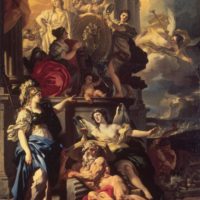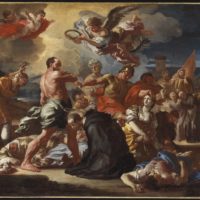In painting titled Dido Receiving Aeneas and Cupid Disguised as Ascanius, Dido, the queen of Carthage, appears in the story of Trojan Wars more as a victim than having any deliberate role in the Trojan War or in any consequences.
When Aeneas, first of the Trojan War Heroes, fled from Troy seeking shelter in different lands, islands and cities, he didn’t found a permanent place before he built city of his own called Rome. Though, before building Rome, he travelled in Mediterranean Sea for years and resided in a dozen places.
Dido’s Carthage was one of them. She lived there being the ruling queen has her husband was killed by her brother. On the coming of Aeneas and his comrades, she received them well enough. But, Venus, mother of Aeneas was afraid of Aeneas and his crew’s safety as Goddess Juno hated Aeneas and wanted him to be killed. To make Aeneas’s safety assured she sent her another son – and Aeneas’s half-brother – cupid in disguise of Aeneas’ son Ascanius and asked him to seduce them both to fall in love with each other.
The painting by Baroque era artist (and also a practitioner of chiaroscuro) Francesco Solimena has captured the very moment of Aeneas meeting Dido for the first time in a dramatic and more symbolic way to express the surrounding story of the moment.
Aeneas is in a requesting posture slightly bended towards Dido while indicating towards his son Ascanius by another hand. Ascanius is also kneeled towards the almighty queen for the grant of refuge. But, fact that he is actually not Aeneas’s real son is indicated by the Cupid’s personification at the feet of the queen. The little cupid is shooting his arrows of love to the queen to make her fall in love with Aeneas.
The gaze of the queen Dido is cleverly depicted towards the little cupid. A couple’s gaze while falling in love will reach directly into each other’s eyes. But, here she is gazing towards cupid (about whose presence she wasn’t aware of) meaning that she was provoked to love Aeneas by the deliberate action of the cupid instead of naturally falling in love with him.
People and soldiers around these royal personas are curiously watching over. A lady at the left bottom, is offering a dish consisting – which seems like – a crown and a little sword. Maybe be it indicates Dido’s acceptance of Aeneas as guests which turned out to be a yearlong affair between them and declaring Aeneas her king. In a way every posture of every figure is indicting their current dispositions, power and current relative positions. It’s a cleverly depicted painting with much more information which could be gathered only by deep contemplation.
The painting, in this way, describes a whole chapter from the Aeneas’s journey.




